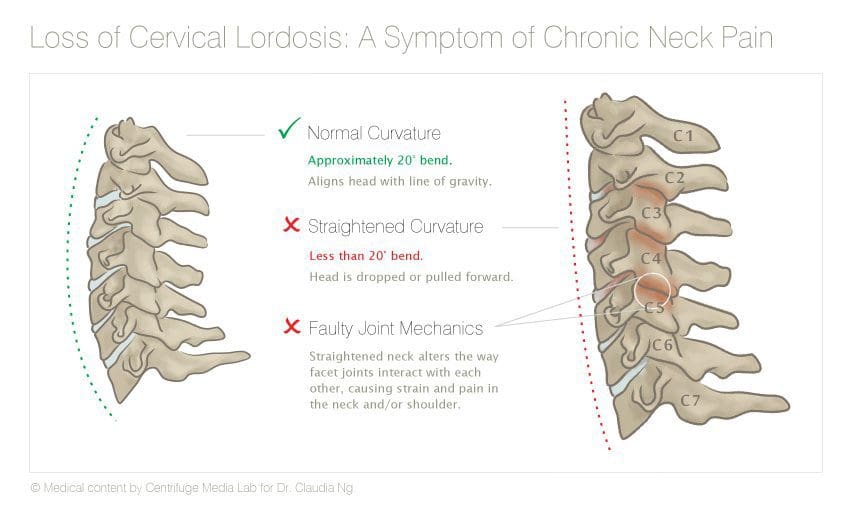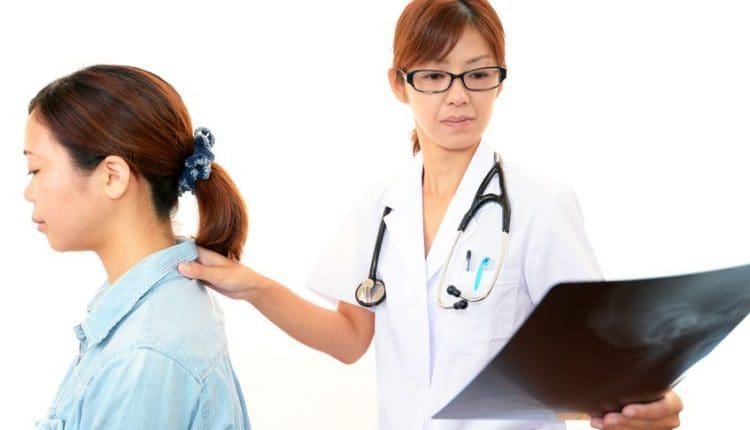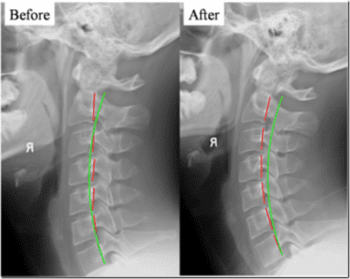The cervical spine is C shaped, with its curve facing towards the rear of neck. The upper part of the spine in the neck is called the cervical spine and it’s composed of 7 cervical vertebra. A healthy cervical spine has a lordotic curve and it is anatomically important to bear the head’s weight.
Reduction of cervical lordosis can result in straightening of the cervical spine or in severe cases it may reverse the curve. The condition is also known as kyphosis. Loss of cervical lordosis may lead to stiffness and pain in the neck. It may also lead to referred pain in the hand, vertigo and many other symptoms.
Improper posture and muscular spasm are two important causes for reduction of cervical curvature. The problem is usually detected on X-rays of the cervical spine and it should be treated soon to prevent further deterioration and complications in the future.
Table of Contents
Causes of Loss of Cervical Lordosis
Loss of cervical curvature usually occurs in adults. Children suffer from this issue as well although it is rare. Both women and men are equally affected. The condition is associated with long standing spasms of muscles in the neck.
Poor neck posture is often the only cause in young individuals. Working on a computer for long periods or doing desk work for long time without taking break can strain the muscles of the neck. The muscles cause a pull on the cervical vertebra. Prolonged pull will automatically disturb the normal alignment of the cervical spine. Injury to cervical spine may also lead to loss of cervical lordosis. A whiplash injury from automobile accident trauma on the neck can contribute to muscle strain and loss of curvature of the cervical spine.
Osteoporosis is another important factor that might cause abnormality in cervical spine curvature. It is mostly seen among elderly individuals. In osteoporosis the bone density of the vertebrae is lost. The weight of normal wear and tear may put pressure on the spine. Obesity and hereditary skeletal disorders, such as achondroplacia, can also change the curvature of the spine. Other less common causes of loss of cervical lordosis include tumor of cervical spine, systemic disease such as ankylosing spondylitis etc.. Radiotherapy for cancer between can also cause loss of spine curvature.
Loss Of Cervical Lordosis Symptoms
Loss of cervical lordosis involves an ongoing gradual procedure. It is a phenomenon. In its start phase the condition remains silent. This means there are no symptoms. And it’s detected accidentally on X-ray meant for some other purpose. After months or years, the individual may present complaints such as pain and stiffness in the neck.

A normal cervical lordosis has a 30 to 40 degree curve. Once the curve gets lesser than 20 degrees, the patient may complain about neck pain. It may lead to tingling in hands and fingers and may lead to cervical disc degeneration. These symptoms aren’t exactly those from compression of cervical vertebra, but because of pinched nerve because of loss of lordosis.
Loss of cervical lordosis also results in tension in the spinal cord and carotid blood vessels which supply blood to the head. Improper blood flow in the brain can result in dizziness, headaches, confusion, tinnitus etc..
Treatment for Loss of Cervical Lordosis
Loss of cervical lordosis may be detected on physical examination from diagnostic tests such as X-ray and MRI of the cervical spine. These evaluations are important to know the magnitude of loss of lordosis and nerve damage.


Medical treatment is only required when pain and stiffness are present. Muscle relaxants and pain killers will help to reduce spasms and pain of neck muscles. This increase the variety of motion of neck and will alleviate the distress.
Once first acute symptoms are relieved patient should start physiotherapy exercises aimed at strengthening the neck muscles and improvement of posture. A simple neck exercise is to bend the head forward and backward. Second exercise is to turn the neck and head sideways five to six times in a day. Severe case of loss of cervical lordosis may require the individual to wear a neck brace during day time and support pillows while sleeping. Both will help to restore the altered curvature of the spine.
The scope of our information is limited to chiropractic and spinal injuries and conditions. To discuss options on the subject matter, please feel free to ask Dr. Jimenez or contact us at 915-850-0900 . 
By Dr. Alex Jimenez
Additional Topics: Automobile Accident Injuries
Whiplash, among other automobile accident injuries, are frequently reported by victims of an auto collision, regardless of the severity and grade of the accident. The sheer force of an impact can cause damage or injury to the cervical spine, as well as to the rest of the spine. Whiplash is generally the result of an abrupt, back-and-forth jolt of the head and neck in any direction. Fortunately, a variety of treatments are available to treat automobile accident injuries.
<
div class=”video-container”>
<
iframe src=”https://www.waxwinginteractive.com/manage/admin/playembed.php?vid=2&client=1350 scrolling=”no” border-width=”0″>

TRENDING TOPIC: EXTRA EXTRA: New PUSH 24/7Â®ï¸ Fitness Center
Post Disclaimer
Professional Scope of Practice *
The information herein on "Whiplash Specialist: Identifying Loss of Cervical Curvature" is not intended to replace a one-on-one relationship with a qualified health care professional or licensed physician and is not medical advice. We encourage you to make healthcare decisions based on your research and partnership with a qualified healthcare professional.
Blog Information & Scope Discussions
Welcome to El Paso's Chiropractic Scientist wellness blog, where Dr. Alex Jimenez, DC, FNP-C, a board-certified Family Practice Nurse Practitioner (FNP-C) and Chiropractor (DC), presents insights on how our team is dedicated to holistic healing and personalized care. Our practice aligns with evidence-based treatment protocols inspired by integrative medicine principles, similar to those found on dralexjimenez.com, focusing on restoring health naturally for patients of all ages.
Our areas of chiropractic practice include Wellness & Nutrition, Chronic Pain, Personal Injury, Auto Accident Care, Work Injuries, Back Injury, Low Back Pain, Neck Pain, Migraine Headaches, Sports Injuries, Severe Sciatica, Scoliosis, Complex Herniated Discs, Fibromyalgia, Chronic Pain, Complex Injuries, Stress Management, Functional Medicine Treatments, and in-scope care protocols.
Our information scope is limited to chiropractic, musculoskeletal, physical medicine, wellness, contributing etiological viscerosomatic disturbances within clinical presentations, associated somato-visceral reflex clinical dynamics, subluxation complexes, sensitive health issues, and functional medicine articles, topics, and discussions.
We provide and present clinical collaboration with specialists from various disciplines. Each specialist is governed by their professional scope of practice and their jurisdiction of licensure. We use functional health & wellness protocols to treat and support care for the injuries or disorders of the musculoskeletal system.
Our videos, posts, topics, subjects, and insights cover clinical matters, issues, and topics that relate to and directly or indirectly support our clinical scope of practice.*
Our office has reasonably attempted to provide supportive citations and has identified the relevant research studies or studies supporting our posts. We provide copies of supporting research studies available to regulatory boards and the public upon request.
We understand that we cover matters that require an additional explanation of how they may assist in a particular care plan or treatment protocol; therefore, to discuss the subject matter above further, please feel free to ask Dr. Alex Jimenez, DC, APRN, FNP-BC, or contact us at 915-850-0900.
We are here to help you and your family.
Blessings
Dr. Alex Jimenez DC, MSACP, APRN, FNP-BC*, CCST, IFMCP, CFMP, ATN
email: coach@elpasofunctionalmedicine.com
Licensed as a Doctor of Chiropractic (DC) in Texas & New Mexico*
Texas DC License # TX5807
New Mexico DC License # NM-DC2182
Licensed as a Registered Nurse (RN*) in Texas & Multistate
Texas RN License # 1191402
ANCC FNP-BC: Board Certified Nurse Practitioner*
Compact Status: Multi-State License: Authorized to Practice in 40 States*
Graduate with Honors: ICHS: MSN-FNP (Family Nurse Practitioner Program)
Degree Granted. Master's in Family Practice MSN Diploma (Cum Laude)
Dr. Alex Jimenez, DC, APRN, FNP-BC*, CFMP, IFMCP, ATN, CCST
My Digital Business Card





 Again, We Welcome You.
Again, We Welcome You.
Comments are closed.